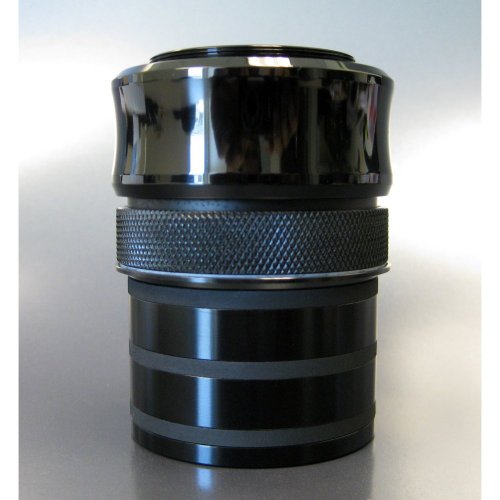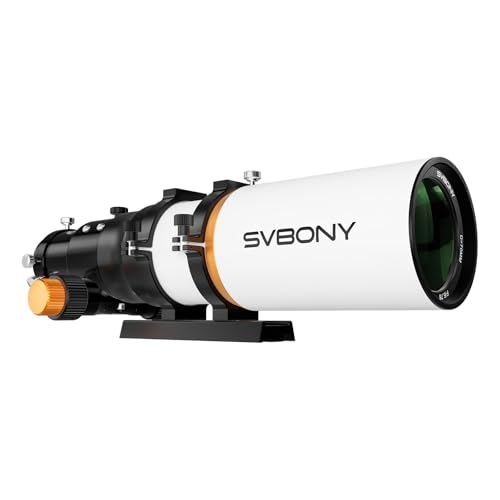If you’re looking for the best field flatteners for refractor telescopes that deliver sharp, distortion-free images, I’ve got you covered. I’ve found several top models like Explore Scientific, SVBONY, and Astromania, all designed to correct field curvature and support full-frame cameras. These flatteners improve edge-to-edge sharpness and contrast, making deep-sky imaging much clearer. Keep going to learn about the key features, compatibility tips, and choosing the perfect flattener for your setup.
Key Takeaways
- Top field flatteners correct field curvature to produce sharp, distortion-free images across the entire sensor for refractor telescopes.
- Compatible with focal ratios typically between f/4 and f/8, ensuring optimal flat-field performance.
- Features multi-coated optics and precise spacing (around 55mm) for enhanced contrast and minimal star distortion.
- Support full-frame cameras and wide-field imaging, expanding sky coverage for astrophotography.
- Compact, lightweight designs ideal for portable setups and field use, with easy mounting options for various telescope models.
Explore Scientific Field Flattener for Refractor Telescopes
If you’re serious about astrophotography with your refractor telescope, the Explore Scientific Field Flattener is an excellent choice, especially if your focal ratio falls between f/5 and f/7. It effectively reduces star distortion caused by field curvature, ensuring sharp, round stars across your entire image. Designed with compatibility in mind, it works with telescopes requiring 55mm (+/- 2mm) spacing between the camera and device. Its fully multi-coated optical glass maximizes light transmission, delivering high-contrast images of planets, nebulae, and galaxies. Compact and durable, it’s easy to attach and reliably produces flat, detailed astrophotographs, making it a top pick for enthusiasts.
Best For: astrophotographers using refractor telescopes with focal ratios between f/5 and f/7 seeking high-quality, flat-field images.
Pros:
- Effectively minimizes star distortion caused by field curvature, ensuring sharp, round stars across the entire image.
- Fully multi-coated optical glass maximizes light transmission for high-contrast astrophotography.
- Compact, durable design with easy attachment makes it suitable for field use and portable setups.
Cons:
- Requires precise spacing of 55mm (+/- 2mm) between the device and camera sensor for optimal performance.
- Compatibility limited to telescopes within specific focal ratios (f/5 to f/7).
- Slightly higher price point compared to basic flatteners, which may be a consideration for budget-conscious users.
SVBONY Focal Reducer for SV503 102mm ED Telescope
The SVBONY Focal Reducer for the SV503 102mm ED telescope stands out as an excellent choice for astrophotographers seeking to expand their sky view while maintaining sharp, distortion-free images. It offers a 0.8x reduction, broadening the field of view and producing finer star points, ideal for full-frame celestial photography. Constructed with durable, multi-coated optics and a lightweight anodized aluminum body, it’s built to last and easy to handle. Compatibility features include a standard 2-inch filter thread and M48 back end for camera connections. Proper installation, including removal of the nose piece, guarantees maximum focus and flat, clear images across the frame.
Best For: astrophotographers using the SV503 102mm ED telescope who want to enhance their wide-field imaging with sharp, distortion-free stars and improved sky coverage.
Pros:
- Provides a 0.8x reduction for a wider field of view and finer star points
- Durable, multi-coated optics with a lightweight, corrosion-resistant aluminum body
- Compatible with standard filter threads and camera connections, facilitating easy setup
Cons:
- Removal of the nose piece may be necessary for proper focus, which could be challenging for some users
- Achieving exact focus may require experimenting with extension tubes and backfocus adjustments
- Slightly limited to specific telescope models, requiring compatibility checks for different setups
Astromania 2 Field Flattener for Astronomy Photos
For astrophotographers seeking pinpoint sharpness across their entire image field, the Astromania 2 Field Flattener stands out as an excellent choice. It’s designed specifically for refractor telescopes with focal ratios from f/4 to f/8, ensuring compatibility with a wide range of setups. Its M48 thread provides full aperture illumination at 2″ back focus, with space for accessories up to 109mm. The flattener effectively corrects field curvature, delivering sharp stars from center to edges. Plus, multi-coated lenses maximize light transmission and contrast, resulting in high-quality, detailed images. It’s a reliable tool for achieving professional-level astrophotography results.
Best For: astrophotographers using refractor telescopes with focal ratios from f/4 to f/8 seeking to achieve pinpoint sharpness and flat field images in their astrophotography.
Pros:
- Corrects field curvature for sharp images across the entire field
- Compatible with a wide range of refractor telescopes (f/4 to f/8)
- Multi-coated lenses enhance light transmission, contrast, and image quality
Cons:
- Designed specifically for refractor telescopes, not compatible with other types
- Requires a back focus of 2″ and accessory space up to 109mm, which may limit certain setups
- May be more expensive compared to simpler focal reducers or adapters
SVBONY SV193 Focal Reducer 2 Inch 0.8X Field Flattener
Astrophotographers seeking crisp, edge-to-edge images will find the SVBONY SV193 Focal Reducer 2 Inch 0.8X Field Flattener an excellent choice, especially when working with full-frame cameras. Designed specifically for refractors like the SV503 80ED, it reduces focal length to widen the field of view while ensuring uniform illumination. Its dual role as a focal reducer and field flattener minimizes star distortion at the edges, resulting in sharp, professional-grade images. With a standard 2-inch front socket and M48 threading at the rear, it’s compatible with popular cameras like the SV305C, making it versatile and easy to integrate into your astrophotography setup.
Best For: astrophotographers using refractor telescopes with full-frame cameras who want to achieve sharp, edge-to-edge celestial images with minimized star distortion.
Pros:
- Reduces focal length to widen the field of view for expansive astrophotography.
- Acts as a field flattener, ensuring sharp images across the entire sensor.
- Compatible with standard 2-inch accessories and M48 threaded cameras like the SV305C.
Cons:
- Designed primarily for refractor telescopes, limiting versatility with other types.
- May require additional adapters for certain camera models or setups.
- Slightly more complex setup process for beginners unfamiliar with focal reducers and field flatteners.
SVBONY SV503 Portable Telescope Tube
If you’re seeking a portable telescope tube that combines premium optical quality with versatile use, the SVBONY SV503 stands out. It features an objective lens with S-FPL51 ED glass, virtually eliminating chromatic aberration for sharp, high-contrast images perfect for astrophotography and visual observation. Its doublet air-spaced achromatic design guarantees excellent clarity across various targets like the moon, nebulae, and galaxies. The 2-inch rack and pinion focuser provides precise control and securely supports heavy accessories. Built for travel and outdoor use, the SV503 offers reliable performance for both beginners and experienced astronomers, making it an excellent choice for sharp, detailed imaging wherever you go.
Best For: experienced and beginner astronomers seeking a portable, high-quality telescope for astrophotography and detailed visual observation.
Pros:
- Features S-FPL51 ED glass to virtually eliminate chromatic aberration for sharp, high-contrast images.
- Equipped with a precise 2-inch rack and pinion focuser that securely supports heavy accessories.
- Compact and lightweight design optimized for travel and outdoor use, suitable for various observational targets.
Cons:
- May require additional accessories or mounts for complete astrophotography setups.
- The doublet achromatic design, while excellent, might not match the performance of apochromatic triplets for some advanced users.
- As a portable telescope, it may have limitations in aperture size compared to larger, stationary telescopes.
HOTECH SCA 2 Inch Field Flattener for Refractor Telescopes
The HOTECH SCA 2 Inch Field Flattener stands out as an excellent choice for those using refractor telescopes with focal ratios between f5 and f8. Its fully multi-coated two-element lens maximizes light transmission, providing bright, sharp images across the entire field. Compatible with standard 2”/48mm filter threads and all 35mm cameras via T-ring, it offers great versatility. The built-in center-loading T-adapter with compression and rubber rings guarantees precise camera centering and stable alignment. Its compact, user-friendly design enhances imaging quality by maintaining proper optical alignment, making it a reliable tool for astrophotographers seeking consistently clear and flat images.
Best For: astrophotographers using refractor telescopes with focal ratios between f5 and f8 seeking sharp, flat images across their entire field of view.
Pros:
- Fully multi-coated two-element lens maximizes light transmission for bright, crisp images
- Compatible with standard 2” filters and all 35mm cameras via T-ring for versatile imaging options
- Built-in center-loading T-adapter ensures precise camera centering and stable alignment
Cons:
- Designed specifically for focal ratios f5 to f8, less suitable for faster or slower telescopes
- May require additional accessories for compatibility with some camera models or mounts
- Slightly larger or heavier compared to simpler single-element flattener options
SVBONY SV503 Refractor Telescope with Built-in Field Flattener
For those seeking a versatile, all-in-one solution, the SVBONY SV503 Refractor Telescope with Built-in Field Flattener stands out as an excellent choice. Its 70mm aperture and F/6.78 focal ratio produce bright, sharp images of galaxies, nebulae, and star clusters. The integrated flat-field design, combined with ED glass, guarantees minimal chromatic aberration and true-to-life colors while eliminating edge distortions. The dual-speed focuser allows precise adjustments for both quick and fine focusing, making it ideal for astrophotography. Plus, the stable mounting clamp provides steady, vibration-free views. Overall, it’s a user-friendly, high-performance telescope perfect for both visual observing and astrophotography.
Best For: Amateur astronomers and astrophotography enthusiasts seeking an all-in-one, high-quality refractor telescope with excellent image clarity and ease of use.
Pros:
- Integrated flat-field design with ED glass minimizes chromatic aberration and edge distortions.
- Dual-speed focuser allows precise and quick focusing adjustments for detailed imaging.
- Stable mounting clamp ensures vibration-free, steady views suitable for both visual and astrophotography use.
Cons:
- 70mm aperture may limit deep-sky object brightness compared to larger telescopes.
- Focal ratio of F/6.78 might require longer exposures for some astrophotography applications.
- Compact design may have limited field of view for very wide-angle observations.
SVBONY SV260 2 Telescope Filter for SV503 Refractor
The SVBONY SV260 2 Telescope Filter is an excellent choice for astrophotographers and deep-sky enthusiasts looking to improve image clarity amid light pollution. This 5-bandpass broadband filter effectively blocks artificial light while transmitting over 90% of celestial signals, revealing more detail in nebulae and starfields. Its high transmittance restores true colors, making astrophotos more vibrant and accurate. Designed for the SV503 refractor with a built-in field flattener, it ensures wide, flat views without distortion. Whether capturing colorful nebulae or bright galaxies, this filter enhances contrast and detail, making it a valuable tool for deep-sky imaging in challenging lighting conditions.
Best For: amateur and professional astrophotographers seeking to enhance deep-sky imaging quality in light-polluted environments.
Pros:
- High over 90% peak transmittance for vibrant, true-to-life colors.
- Effectively blocks artificial light pollution, revealing detailed celestial features.
- Designed specifically for the SV503 refractor with built-in field flattener for wide, distortion-free views.
Cons:
- May require additional accessories or adapters for compatibility with non-SV503 telescopes.
- Performance can be limited in extremely severe light pollution environments.
- Slightly higher cost compared to basic filters, reflecting its multi-bandpass capabilities.
Sky-Watcher Evolux 62ED Reducer/Flattener (0.9X)
If you’re aiming for sharp, flat-field astrophotography with your refractor telescope, the Sky-Watcher Evolux 62ED Reducer/Flattener (0.9X) is an excellent choice. It features a 62mm aperture, an f/5.8 focal ratio, and a 360mm focal length, making it ideal for wide, detailed images. The device includes an ED element to improve image quality and a built-in rotator with a filter cavity, streamlining filter use during sessions. Its compact size and lightweight design (around 0.88 pounds) make it easy to handle and install, ensuring sharper, clearer images with shorter exposure times and minimal field curvature.
Best For: amateur astrophotographers seeking a compact, high-quality reducer/flattener to produce sharp, wide-field images with minimal field curvature.
Pros:
- Includes an ED element for enhanced image clarity and reduced chromatic aberration
- Compact, lightweight design (around 0.88 pounds) for easy handling and installation
- Built-in rotator with filter cavity simplifies filter management during imaging sessions
Cons:
- Limited back focus (55mm), which may require additional adapters for certain setups
- Designed specifically for flat field astrophotography, not general visual use
- Compatible primarily with specific threading (M56x1 female and M48 male), limiting versatility with other equipment
SVBONY SV209 Field Flattener 0.8X Focal Reducer for Telescopes
The SVBONY SV209 Field Flattener 0.8X Focal Reducer stands out for astrophotographers seeking sharper, wider-field images from their SV550 122mm f/7 APO refractor. It reduces focal length from 854mm to 683.2mm, increasing imaging speed and field of view. Designed for prime focus astrophotography and terrestrial shots, it corrects field curvature to produce flat, round stars across the entire frame. Compatible with DSLR and CCD cameras, it features a secure metric 63x1mm thread for easy installation. While some users note focus adjustments are sensitive to extension length, overall, it offers significant improvements in image sharpness and edge clarity when properly set up.
Best For: astrophotographers using the SV550 122mm f/7 APO refractor seeking to enhance image sharpness, widen their field of view, and correct field curvature for both astrophotography and terrestrial photography.
Pros:
- Significantly reduces focal length, enabling faster, wider-field imaging.
- Corrects field curvature for sharp, flat-star images across the entire frame.
- Compatible with DSLR and CCD cameras, with secure metric threading for easy installation.
Cons:
- Focus adjustments can be sensitive to extension tube length, requiring precise setup.
- Variations in extension tube measurements may affect focus and star shape, leading to potential image quality issues.
- Some initial units may have manufacturing defects, such as coating flaking, though replacements have improved quality.
SVBONY SV503 Refractor Telescope, 102mm F7 Achromatic Refractor
For astrophotographers seeking sharp, distortion-free images across the entire field of view, the SVBONY SV503 Refractor Telescope offers an excellent foundation, especially with its 102mm aperture and F7 focal ratio. Its doublet air-spaced achromatic lens with S-FPL51 ED glass reduces chromatic aberration, ensuring vivid, true-to-color images. Fully multi-coated optics maximize light transmission and contrast. The dual-speed focuser provides precise adjustments, while the 360° field rotator simplifies framing. Its sturdy metal construction, extendable dew shield, and portable size make it ideal for travel and long-term use. Overall, it’s a versatile, high-quality scope suitable for various astrophotography and visual applications.
Best For: amateur and intermediate astrophotographers seeking a portable, high-quality refractor telescope with excellent optical performance for planetary, lunar, and deep sky imaging.
Pros:
- Reduced chromatic aberration with doublet air-spaced achromatic lens and S-FPL51 ED glass for sharp, colorful images
- Fully multi-coated optics for maximum light transmission, contrast, and minimal stray light
- Sturdy metal construction with smooth dual-speed focuser and 360° field rotator for precise framing and focusing
Cons:
- Slight corner star distortion when using reducers, which may require post-processing correction
- Limited back focus (90mm), potentially restricting certain filters or accessories without spacers
- Compact size may limit aperture size for some deep sky objects compared to larger telescopes
SVBONY SV193 Focal Reducer 2 Inch 0.8X Telescope Accessory
Astrophotographers seeking sharper, wider-field images will find the SVBONY SV193 Focal Reducer 2 Inch 0.8X an excellent choice because it effectively reduces focal length while flattening the field, minimizing star distortion at the edges. Compatible with SV503 80mm F7 ED telescopes and other refractors, it features a standard 2-inch front socket and M48x0.75 threaded back end for easy camera attachment, supporting full-frame sensors. It cuts exposure times by 20%, broadening the field of view. Designed as both a focal reducer and field flattener, it delivers bright, sharp images, although some slight star elongation might occur at the edges, requiring minor post-processing.
Best For: astrophotographers using compatible refractors or telescopes like the SV503 80mm F7 ED seeking to achieve wider, sharper images with reduced exposure times.
Pros:
- Effectively reduces focal length by 0.8x, expanding the field of view for capturing larger celestial areas.
- Acts as both a focal reducer and field flattener, minimizing star distortion at edges for sharper images.
- Supports full-frame cameras and 2-inch filters, offering versatile compatibility with various imaging setups.
Cons:
- Some users may experience minor star elongation at the edges, requiring post-processing adjustments.
- Occasional defects such as coating spots or damage during shipping have been reported.
- Customer service experiences vary, with some delays or difficulty obtaining replacements for defective units.
Astromania 2 Field Flattener for Astronomy Photos
If you’re seeking a reliable field flattener that delivers sharp, flat images across your entire refractor telescope’s field, the Astromania 2 Field Flattener is a solid choice. It’s compatible with refractors from F4 to F8 and features an M48 thread for full aperture illumination at 2 inches back focus. Designed to correct field curvature, it produces pin-sharp stars edge to edge, ideal for astrophotography. The multi-coated lenses enhance image quality by reducing reflections and increasing light transmission. Portable and lightweight at just over six ounces, it’s easy to handle during sessions. While setup can be tricky, support and patience lead to excellent results.
Best For: amateur astronomers and astrophotographers seeking a portable, effective field flattener compatible with refractor telescopes from F4 to F8 for capturing sharp, flat images across the entire field.
Pros:
- Produces pin-sharp stars from edge to edge, correcting field curvature effectively
- Multi-coated lenses enhance image quality by reducing reflections and increasing light transmission
- Lightweight and portable, weighing just over six ounces for easy handling during sessions
Cons:
- Setup process can be challenging without detailed manuals or instructions
- Customer support experiences vary, with some users finding assistance unhelpful
- Initial adjustments may require patience and trial to achieve optimal focus and flat fields
SVBONY SV220 Dual-Band Nebula Filter with SV503 70mm Refractor Telescope
The SVBONY SV220 Dual-Band Nebula Filter paired with the SV503 70mm Refractor Telescope offers an excellent solution for amateur astronomers seeking to enhance their nebula observations and astrophotography. The SV503’s 70mm aperture and flat-field design provide bright, sharp, distortion-free images of galaxies and nebulae, while the built-in field flattener minimizes edge blur. The dual-band filter reduces light pollution from moonlight and streetlights, boosting contrast and detail without brightening the nebulae themselves. This combination improves visibility and imaging quality across various sky conditions, making it ideal for both visual observation and capturing detailed astrophotos of gaseous objects.
Best For: amateur astronomers and astrophotographers seeking to improve nebula observation and imaging quality under various sky conditions.
Pros:
- Enhances contrast and detail in nebulae and gaseous objects without increasing brightness.
- Flat-field design and built-in field flattener provide sharp, distortion-free images across the entire field of view.
- Effective at reducing light pollution from moonlight and streetlights, improving visibility during both visual and photographic sessions.
Cons:
- Limited to dual-band nebulae, less effective for other types of celestial objects.
- Requires compatible telescope and mounting setup, possibly needing additional accessories for optimal use.
- May not completely eliminate all light pollution effects in heavily light-polluted areas.
Factors to Consider When Choosing Field Flatteners for Refractor Telescopes

When selecting a field flattener, I consider how well it matches my telescope’s focal ratio and guarantees ideal image quality. I also look at the coating quality, ease of installation, and whether it covers my desired field of view. Finally, compatibility with my mount and connection types plays a key role in making the right choice.
Compatibility With Focal Ratios
Choosing a field flattener that matches your telescope’s focal ratio is crucial for peak performance. Most flatteners are designed for specific focal ratios, typically between f/4 and f/8, to ensure ideal correction of field curvature. Using a flattener outside its recommended range can cause star distortion, vignetting, or uneven illumination, degrading image quality. Many flatteners specify their perfect focal ratio range to help you select the right one for your setup. Proper compatibility means the flattener works with your telescope’s focal ratio, ensuring sharp, evenly illuminated images across the entire field of view. Failing to match these specifications can lead to aberrations that compromise your astrophotography results. Always double-check your telescope’s focal ratio before choosing a field flattener for best results.
Optical Coating Quality
Optical coating quality plays a significant role in how well a field flattener performs, especially for astrophotography. High-quality coatings, like fully multi-coated lenses, maximize light transmission and reduce reflections, resulting in brighter, clearer images. Multi-coated or dielectric coatings improve contrast and color fidelity by minimizing internal light scatter and flare within the device. Durability is also essential; premium coatings resist scratches, dust, and moisture, guaranteeing long-term performance. Properly applied coatings help maintain minimal light loss across the visible spectrum, which is critical for accurate imaging. High transmittance and low reflectance coatings contribute to sharp, flat images with minimal star distortion at the edges. Overall, investing in a field flattener with excellent optical coatings ensures superior image quality and consistent results.
Field of View Coverage
Have you ever noticed how some images show star elongation or distortion at the edges? That’s often due to insufficient field of view coverage from your field flattener. The coverage determines how much of your image sensor or eyepiece’s view is corrected for flatness, directly affecting sharpness across the entire field. Most flatteners are designed to work best with specific sensor sizes, like APS-C or full-frame, which influences their coverage area. A larger coverage ensures the whole image remains in focus, free of distortions or star elongation. The effective coverage is usually specified as a diameter in millimeters, indicating the maximum sensor size or image circle it can handle properly. Using a flattener beyond its recommended coverage can cause distortions, degrading your image quality substantially.
Mounting and Connection Types
When selecting a field flattener for your refractor telescope, it’s essential to pay close attention to its mounting and connection options. Most flatteners connect via standard 2-inch or T-thread interfaces, so ensuring compatibility with your focuser or visual back is crucial. Many models include built-in T-ring threads or adapters, making it easier to attach cameras like DSLRs or CCDs securely. Proper mounting requires verifying that the connection type matches your telescope’s output and your camera’s input to maintain precise alignment. Additionally, achieving the correct back focus distance, usually around 55mm, is vital for optimal performance. Some flatteners come with spacers or adjustable components to help you fine-tune this distance. Compatibility with your specific telescope model and focal ratio is also key to avoiding star distortion or vignetting.
Ease of Installation
Choosing a field flattener that’s easy to install can save you time and frustration, especially if you’re new to astrophotography. Look for models with compatible mounting threads or adapters that match your telescope’s focuser or camera system, making setup straightforward. Clear, precise alignment marks or guides are essential—they help ensure correct attachment and orientation without guesswork. The design should allow easy access to focus adjustments, so you don’t have to disassemble other components. Lightweight and compact options make setup quick and reduce the chance of misalignment. Additionally, user-friendly instructions or visual guides can make installation even easier, giving you confidence in your setup. Convenience here helps you focus more on capturing stunning images rather than wrestling with equipment.
Price and Brand Reputation
Price and brand reputation are important factors to contemplate when selecting a field flattener for your refractor telescope. Reputable brands with positive customer reviews tend to produce more reliable and durable products, reducing the chance of optical flaws. Higher-priced options often feature better coatings, precise alignment, and superior construction, which translate into sharper, more consistent images. Established manufacturers typically offer strong customer support, warranties, and detailed documentation, making troubleshooting easier. A well-known brand’s reputation is usually reflected in product ratings and reviews, giving you confidence in quality control and performance. Investing in recognized brands can also ensure compatibility with your specific telescope model and accessories, helping to avoid fit and function issues. Ultimately, choosing reputable brands and considering price helps you get the best value and performance.
Frequently Asked Questions
How Do Field Flatteners Impact Astrophotography Exposure Times?
Field flatteners can reduce exposure times in astrophotography by providing sharper, more uniform images across the frame. When the field is flatter, I don’t have to compensate for distortion or focus issues, which means I can capture clear images faster. This efficiency saves me time during long exposures, helping me get better results with less effort and minimizing star trailing or blurring caused by optical imperfections.
Can Field Flatteners Be Used With All Refractor Telescope Brands?
Not all field flatteners work with every refractor telescope brand. I’ve found that compatibility depends on your specific telescope’s design and focal ratio. It’s essential to verify the manufacturer’s recommendations before purchasing. I always ensure the flattener matches my scope’s specifications to avoid vignetting or image distortion. Doing this guarantees you get sharp, clear images without any hassle, making your astrophotography experience much smoother.
What Maintenance Is Required for Long-Term Use of Field Flatteners?
For long-term use, I recommend regularly cleaning your field flattener with a soft, lint-free cloth and lens cleaner to prevent dust and smudges. I also check for any signs of wear or misalignment and tighten screws if needed. Storing it in a dry, dust-free environment helps preserve its quality. Routine maintenance ensures sharp, clear images and extends the lifespan of your field flattener.
Do Field Flatteners Affect the Weight and Balance of My Telescope Setup?
Oh, absolutely, adding a field flattener is like inviting a tiny weight lifter into your telescope setup. It can slightly tip the balance, making your mount work a little harder. But don’t worry, most flatteners are lightweight and won’t turn your perfect setup into a teeter-totter. Just a quick tweak here and there, and you’re back to stellar, sharp images without the weighty drama.
Are There Differences in Image Quality Between Built-In and External Field Flatteners?
Yes, there are differences in image quality between built-in and external field flatteners. I’ve found that external flatteners often provide more precise correction, resulting in sharper images across the entire field. Built-in flatteners are convenient, but they sometimes compromise image quality at the edges. I recommend testing both options if possible, to see which best suits your telescope and observing needs for consistently clear, sharp images.
Conclusion
Choosing the right field flattener is like finding the perfect lens for a camera—it’s all about clarity and precision. When I select one, I see my celestial images sharpened, just like a well-tuned instrument. Remember, the right flattener transforms a blurry, curved sky into a flat, vivid tapestry. So, take your time, consider your needs, and you’ll unveil stunning, crisp images that bring the universe’s beauty into perfect focus.

























